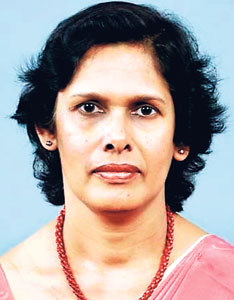The lives of stroke victims can be saved and the severe debilitation left behind by strokes can also be minimized. Although stroke is a catastrophe, it is not only preventable but also treatable.
However, limited facilities for management and rehabilitation in developing countries such as Sri Lanka result in a poorer outcome with higher mortality. Once faced with a stroke 10% die within 30 days, 50% remain disabled after six months and only 30% are functionally independent at one year.
 |
| Dr. Padma Gunaratne |
But the good news is that tremendous recent advances in understanding the pathogenesis, coupled with the advent of superb non-invasive diagnostic techniques and evidence from randomized clinical trials of effective strategies to prevent and treat stroke, have seen stroke medicine establish itself as one of the “frontiers of medicine” and a multidisciplinary speciality in its own right.
Until recently the progress of stroke care was hindered by ignorance, nihilism and negativity both within and outside the medical profession. This has changed in the past few decades.
This was the strong message given through the Presidential address at the inauguration of the 2nd annual Scientific Sessions of the Association of Sri Lankan Neurologists and the International Stroke Conference recently.
The address on the theme ‘A step forward in stroke care in Sri Lanka’ by President Dr. Padma Gunaratne was read out as she was unavoidably unable to attend the sessions.
Diagnosis of stroke
In majority of patients, accurate diagnosis of stroke could be made purely based on clinical history. The sudden onset of neurological symptoms is the most important and characteristic feature. Nevertheless, management will depend on whether the patient had a cerebral haemorrhage or an infarction.
For instance, infarctions are treated with thrombolytics given within three hours of the onset of symptoms. A significant proportion of infarctions could be prevented by prescribing aspirin and warfarin if the thrombo-embolism is from a cardiac source. Endarterectomy of significant symptomatic carotid stenosis averts recurrent stroke in the carotid territory. Certain venous infarcts need long-term warfarinization. Certain cerebral haemorrhages may need vascular studies for evaluation.
The introduction of magnificent radiological investigation in the 1970s -- CT scanning of the brain, was a landmark in stroke care. CT scan of the brain is obligatory to differentiate between a cerebral haemorrhage and an infarction.
The first CT machine was installed at the National Hospital of Sri Lanka two decades ago and since then 19 more machines have been installed in state hospitals under the Ministry of Health. A brain scan is a basic investigation for stroke, equivalent to an ECG when diagnosing a myocardial infarction.
Nevertheless, often, stroke victims from rural Sri Lanka are not scanned. Although it is clear that we need to have a few more CT machines, I wish to emphasize that we are in an era where all clinicians should routinely request a CT brain scan for all stroke patients.
Thrombolysis for acute stroke
If it is a cerebral infarction there is an ischaemic penumbra that is dysfunctional but salvageable around the infarcted tissue. Thrombolysis with Recombinant Tissue Plasminogen Activator given within the first three hours is the specific form of treatment to salvage this ischaemic tissue.
Treating patients with thrombolytics is associated with a greater reduction in death or dependency, equivalent to 126 fewer dead or dependent patients per 1000 patients treated. The convincing effectiveness of thrombolysis has led in some of the developed countries to rule that not offering thrombolytics to acute stroke patients in fact amounts to medical negligence.
The first programme of thrombolysis in the public sector hospitals was initiated in Sri Lanka in March 2007 at the National Hospital. Since then all acute stroke admissions to the National Hospital were screened and 19% of the selected acute stroke victims were thrombolysed. The knowledge on the availability of a specific mode of treatment had led some of the affected to reach hospital within two hours even from a distance of 20 kms away.
Nevertheless, non-availability of adequately allocated beds for stroke patients at the National Hospital of Sri Lanka hindered giving adequate publicity for this programme, depriving the treatment for a significant proportion of deserving patients.
As at present thrombolysis is not available in any of the other public sector hospitals. Since thrombolysis was proven to be effective and more and more studies have confirmed its safety even in primary care settings with facilities for CT scanning, it is important to initiate programmes for this vital form of treatment at other large hospitals with CT facilities.
(Part II: Stroke Units and a suitable model for Sri Lanka)
Discovering Stroke
Stroke, the brain equivalent of a heart attack, was first described by the father of medicine, Hippocrates more than 2,400 years ago. It was called “apoplexy” because of the way it strikes people down.
Later in the 1600s Jacob Wepfer from Switzerland found that patients who died with “apoplexy” had either bleeding into the brain or a blockage in one of the brain’s blood vessels.
Sri Lankan statistics
Stroke strikes down 11 per 1,000 population in Sri Lanka and is the fifth leading cause of hospital deaths. All over the world it is the third leading cause of deaths. A majority of stroke deaths in Sri Lanka occur out of hospital and if they are included, stroke is likely to be the third leading cause of deaths.
Stroke is the leading cause of adult disability and according to the World Health Organization loss of productivity caused by the disability and the cost involved in the management of stroke could be significant enough to have an impact on the economy of a country.
Ageing being a risk factor, it is predicted that 20% of the population in Sri Lanka by 2020 would be more than 65 years old indicating that there will be a significant stroke burden for the country by that time.
These factors highlight the value of restructuring stroke care and implementing a National Stroke Care Programme in Sri Lanka. |

